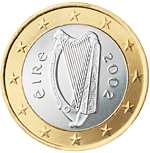Trinity College Harp

The Trinity College harp (also known as Brian Boru's Harp) is a medieval musical instrument on display in the long room at Trinity College Dublin in Ireland. It is an early Irish harp or wire strung cláirseach. It is dated to the 14th or 15th century and, along with the Queen Mary Harp and the Lamont Harp, is one of the three oldest surviving Gaelic harps.[1] The harp was used as a model for the coat of arms of Ireland.
History

It is uncertain who commissioned the Trinity College harp, although structural evidence suggests it was made in the 15th century. It is similar in construction and design to the Queen Mary Clarsach in Scotland. It is likely, however, that the harp was made for a member of an important family, for it is skilfully constructed and intricately ornamented.

According to Charles Vallancey writing in 1786, it was reputedly once owned by Brian Boru, High King of Ireland.[2] However, this link was dismissed by George Petrie in 1840 as "a clumsy forgery, which will not bear for a moment the test of critical antiquarian examination." Petrie dates its construction "to the fourteenth, or more probably to the early part of the fifteenth century."[3]
The harp bears the coat of arms of the O'Neills but although there are many theories about its ownership through the centuries, none can be substantiated, with no verifiable evidence remaining to indicate the harp's original owner, or subsequent owners over the next two to three hundred years until it reputedly passed to Henry McMahon of County Clare, and finally to William Conyngham, who presented it to Trinity College in 1782.[4]
The Trinity College harp is the national symbol of Ireland, being depicted on national heraldry, Euro coins and Irish currency. A left-facing image of this instrument was used as the national symbol of Ireland from 1922, and was specifically granted to the State by the Chief Herald of Ireland in 1945.[5] A right-facing image was registered as a trade mark for Guinness in 1876,[6] although it was first used on their labels from 1862.[7] All three surviving Gaelic harps (the others are the Lamont Harp and the Queen Mary Harp) are considered to have been made in Argyll in South-West Scotland sometime in the 14th–15th century.[8]
Appearance
The harp is of a small Low Headed design with brass pins for 29 strings, the longest being c.62 cm. One extra bass pin was added at some point in its playing life. In 1961 the harp was exhibited in London, and it was dismantled and reconstructed by the British Museum into the wider shape it has nowadays, being the playable mediaeval form. The earlier heraldic and trade mark designs that were modelled on it were based on a thinner form that was the result of a bad restoration in the 1830s. Visitors are therefore often surprised at how wide the real harp is, compared to the harp on Irish coins.
References
- ↑ Joan Rimmer, "The Morphology of the Irish Harp", The Galpin Society Journal, vol. 17 (1964): 39-49
- ↑ Vallancey, Charles (1786). "Brien Boiromh's Harp". Collectanea de rebus hibernicus (L. White) 4: 33. Retrieved 13 December 2012.
- ↑ Petrie, George (1840). "Memoir of Ancient Irish Harp preserved in Trinity College". In Edward Bunting. The Ancient Music of Ireland: Arranged for Piano. Courier Dover Publications. pp. 40–44. ISBN 9780486413761. Retrieved 13 December 2012.
- ↑ Flood, William Henry Grattan (1970). A history of Irish music. Praeger. p. 65.
- ↑ The National Library of Ireland, volume: G.O. MS 111G; Folio number: 20; grant dated 9 November 1945.
- ↑ Dennison, S.R. (Stanley Raymond); Oliver McDonagh (1998). Guinness 1886–1939: From Incorporation to the Second World War. Cork University Press. p. 9. ISBN 9781859181751.
- ↑ Yenne, Bill (2007). Guinness: The 250 Year Quest for the Perfect Pint. John Wiley & Sons. ISBN 9780470120521.
- ↑ Keith Sanger and Alison Kinnaird, "Tree of Strings – Crann nan Teud", Kinmor 1992